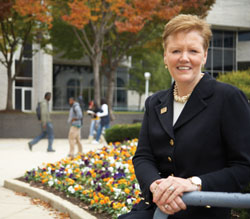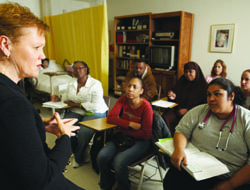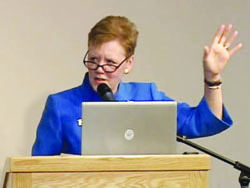Filed Under > Policy
Shaping the Future of Nursing
TC alumna Elaine Tagliareni, President of the 27,000-member National League of Nursing, is redefining opportunity in the helping profession.
A lay observer at the 2008 Oregon Consortium for Nursing Education (OCNE) summit might not have guessed he was watching the aftermath of the profession’s possible equivalent to the signing of the Magna Carta or the adoption of women’s suffrage. Nor would he likely have supposed that, with her keynote speech, Elaine Tagliareni (Ed.D., Nursing Education, 2001) was once again steadying the ropes on a political high-wire act of several years duration.
In a bright blue suit offsetting her short reddish-brown hair, Tagliareni—President of the National League for Nursing (NLN), which serves 27,000 U.S.
“I want you to remember that this is going to have an impact,” Tagliareni said, “and to think, ‘I was a leader in that.’
The work Tagliareni was supporting was a controversial bid to solve Oregon
Five years earlier, the likelihood that OCNE’s fractious membership would ever unite behind such measures seemed slim. Negotiations over how to collaborate to address the shortage had twice broken down in acrimony among faculty backers from the different types of degree programs, who don’t typically interact. Outside mediators had had to step in, and little red “hot button” pins had been distributed for participants to hit when they wanted to call out and address another controversial issue. When the smoke finally cleared, clay “Purple Heart” pins were handed out.
The group had persevered in part because of the support along the way of Tagliareni—herself a graduate of a four-year nursing program at Georgetown, but for the past 25 years a faculty member at the Community College of Philadelphia (CCP) and the first associate degree educator ever to be elected NLN President—who proved an important player on the negotiation’s sidelines.
“Elaine is one of these movers and shakers who have been talking about the need for reforming education for years,” said Christine Tanner, a faculty member at Oregon Health & Science University Oregon
CHAMPION FOR CHANGE
Whether as NLN President, wearing her professor hat, or simply chatting with an interviewer in her office, Tagliareni seems to be all about breaking down stereotypes and moving beyond long-established views.
“Anaïs Nin said, ‘We don’t see things as they are, we see things as we are,’” she told the OCNE group in her keynote address. “As teachers of nursing, we’re called to see the world as it is unfolding. We need to take in data about the world and incorporate it into our thinking. But back when we were taught, our thinking was completely different, right?”
The notion of empowering associate degree nurses is a perfect case in point, challenging prejudices that date back to the creation of the first two-year programs by TC nurse educator Mildred Montag (Ed.D., Nursing Education, 1950) in the 1950s.
“Prior to that time, you had to prove you were single, white and virginal to be a nurse,” Tagliareni says. “But when community colleges opened up, they became a venue for working moms, grandmothers, men—everybody could enter nursing. So not only was it a revolution in the way nursing students were taught, but also in the type of people that moved into nursing.”
But even as associate degree nurses swelled the ranks (Today they make up 60 percent of the nation’s new graduates each year.), nursing itself has undergone equally radical changes.
“A nurse, even when I was in school, would have a patient pre-op for a few days, get to know them, find out what their needs were, be able to focus in on them,” Tagliareni says. “You actually saw the rehab, you saw the full continuum of care, and you were involved with it in a very direct way. Now the hospital environment is not a landing place for cure any more. As the patient, you just stop down for a minute and get whatever it is that you need to have done and move on for your rehab and convalescence and management. To manage that kind of environment, a nurse has to have really unbelievable assessment skills and be able to manage a multitude of problems.”
Hospital patients have grown more challenging, as well. Most are elderly, Tagliareni says, and typically have more than one chronic condition. “They come in with a fractured hip, but they have diabetes, congestive heart failure, arterial sclerotic heart disease and arthritis. Or a client comes in for an acute exacerbation of some pulmonary problem with AIDS, but they already have neuralgia of some sort. They may have depression, too.”
Hence critics’ argument that associate degree nurses need more education (though there may be an element of sour grapes here as well: graduates of two-year programs are allowed to sit for the registered nurse exam, while hospitals hire them to the same jobs and pay them the same salaries that they do graduates of four-year programs).
“There’s a sense that what happens in associate degree programs isn’t as valid and as theoretical and as evidence-based as what’s happening at the baccalaureate level,” Tagliareni says.
Oddly, Tagliareni and the NLN are alone among the major nursing organizations in arguing that all types of degree programs should continue to be considered acceptable entry points to the profession. Their solution: colleges, nursing organizations, governments and hospitals should focus on prompting nurses of all stripes to continue their educations.
Tagliareni’s contemporaries at Teachers College applaud those goals.
“If Elaine can put a new face on what we accept in master’s programs, for example, she can slowly and incrementally refocus the accreditation in order to meet the needs of our marketplace,” says Elaine Rigolosi, Professor of Education and Program Coordinator of TC’s Executive Program for Nurses. “And gradually she can bring nursing education into an arena that is preparing nurses ahead of current market needs while projecting educational requirements toward the future.”
Like Tagliareni, Rigolosi believes nursing education is too focused on its past. “I believe that we cannot hold on to nursing, as it has developed from Florence Nightingale—that’s got to be changed,” she said. “You don’t go and assist a doctor by every bedside or stand in the operating room providing technical assistance. Instead, you’re running a nursing home, or you’re managing an interdisciplinary healthcare facility in the inner city. Nurses do all kinds of things in the fast-moving world of healthcare and nursing practice.”
And nurses need to acquire the skills to assert their rightful role in the healthcare system, says Rigolosi’s colleague, Kathleen O’Connell, Isabel Maitland Stewart Chair and TC Professor of Nursing Education. “We have to produce research that gives evidence for practice. Who’s going to do it if we don’t do it? The drug companies? The equipment companies?”
BLAZING HER OWN TRAIL
Tagliareni’s sympathy for nurses with less high-end education may stem in part from her own experiences bootstrapping it up through the system. Certainly she attended elite institutions, but at several points during her professional career, she found herself in situations where she had to learn fast and on her own.
For example, as part of her master’s degree program at the University of California at San Francisco , where she graduated in 1972, Tagliareni counseled nurses and patients at Moffit Hospital
But then she couldn’t find a job in psycho-physiological nursing, so she went to work as a psychiatric nurse at the Veterans Administration Hospital in Menlo Park
“We didn’t know what Post-Traumatic Stress Disorder was,” Tagliareni says. “We diagnosed everybody as schizophrenic or paranoid schizophrenic. We would give them a small amount of different psychotropic meds because we didn’t know we could give them one in larger doses. We made a lot of mistakes after Vietnam
Her husband joined the faculty at the University of Massachusetts Amherst , in 1976 and two years later, Tagliareni answered a newspaper ad for a nursing faculty position at Greenfield Community College
“I was chatting with the department head, Susan Sherman, and she said, ‘It’s just amazing you know so much about this program,’” Tagliareni recounts. “And I said, ‘Well...,’ and then I told her the story. Needless to say, they hired me.”
Soon after she arrived, Sherman and Verle Waters, now Dean Emerita of Ohlone College in Fremont , California
Tagliareni was put in charge of the project’s Philadelphia-area arm. According to Waters, she thrived.
“Of the six schools that were involved in the project, Elaine threw out the widest net of all,” Waters says. “Part of the plan was to be a sort of lighthouse in your area. And her light shone brighter than anyone else’s.”
Later Sherman became president and CEO of the Independence Foundation, a major Philadelphia
One of her first efforts in that role was to work with the National Nursing Center Consortium, which was trying to develop nurse-managed health centers as safety net providers for the poor, the elderly and other at-risk groups nationwide.
“Here in Philadelphia
Tagliareni also helped lead development of a service learning project at CCP, in which students work in neighboring North Philadelphia —one of the city’s poorest districts—helping public school nurses, assisting local physicians and surveying local health needs.
Meanwhile, she continued to participate in the NLN, serving in various key positions on its Council of Associate Degree Programs. She also continued to think about furthering her own education. In 1997, accompanied by her friend and CCP colleague Liz Speakman (now Assistant Dean of RN programs and an associate professor at Thomas Jefferson School of Nursing), she attended TC’s annual Isabel Maitland Stewart Conference. “I said, ‘Oh my God, I love this place, and it has wainscoting and all that!’” Tagliareni laughs. Both women decided to sign up, on the spot, for doctoral courses.
According to Speakman, TC and Tagliareni were a perfect fit. “TC amplified notions she had that under the right circumstances, everyone can be successful. TC’s philosophy allowed her to flourish.”
STAYING INSPIRED
Tagliareni’s duties as NLN President (a volunteer position) take up an increasing amount of her time these days. When she isn’t traveling the country highlighting innovative nursing experiments like the one in Oregon
Yet it’s in her role as teacher and mentor that Tagliareni clearly feels most at home. After sitting for a long interview one day this past spring, Tagliareni proudly led a visitor on a tour of CCP, pointing out the diversity evident in pictures of year after year of graduates.
“Half the students in the nursing program are minority, and we try very hard to maintain that,” she says. “They come from vulnerable backgrounds and also many of them are the first degree seekers in their families.”
Indeed, Tagliareni is very clear that the socioeconomic role community colleges like CCP play is every bit as important as their impact on the profession of nursing. “In nursing education, especially associate degree, we really move people into the middle class. We teach them nursing, but more importantly, we teach them about being a professional. A lot of times they don’t come to us packaged as somebody who can move into the professional role. We have to teach them that being on time really means coming on time. Then, when you come, you’re prepared, and you look prepared. That’s a new role for nurse faculty.”
At the entrance to one of CCP’s tiny lab rooms, which include mock hospital beds and rather frightening mannequins in hospital johnnies, Tagliareni greeted a student, Tonya Cooper. The two shared a joke.
“I’ve moved farther and farther away from the classroom but never completely left it,” Tagliareni says. “My energy comes from my students and keeping close with them. They love the fact that one of their teachers is President of the National League for Nursing, and they call me Elaine. Because here our philosophical stance is that we educate adult learners. And that the faculty members are co-learners with them. We have more expertise and we know more about nursing—that’s why they came to us, right? But we believe that they see us as colleagues in this journey that they’re about. So we tell them, we are your evaluators, we are your teachers, but we believe that as colleagues you should be able to call us by our first names. Not all nursing programs do that.”
Photographs by Samantha Isom
Published Wednesday, Jan. 7, 2009


